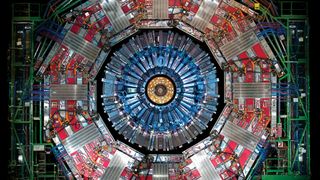Power-boosted Large Hadron Collider is ready to break physics
Have we got everything wrong?

Physicists around the globe are holding their breath as the Large Hadron Collider prepares for its biggest run yet.
Following a last-minute snafu where a weasel short-circuited a high voltage transformer on Friday, researchers are getting ready to run a number of new experiments. In the process, they could uncover particles that could change our understanding of the Universe.
"We are exploring truly fundamental issues, and that's why this run is so exciting," physicist Paris Sphicas told AFP last week. "Who knows what we will find."
Upgrade
The vast machine, which measures 27 kilometres in length, is best known for its role in the discovery of the Higgs Boson in 2012. Since then, however, it has undergone a two-year upgrade to boost its capabilities.
The equipment can now manage energy levels of 13 TeV, up from about eight before the upgrade. That's about the same amount of energy used by 13 mosquitos in flight, which really doesn't sound like much. But in the tubes of the LHC, it represents more than 500,000,000,000,000 protons slamming into each other at almost the speed of light across an area that's too small to be seen even under a microscope. Physics is weird like that.
During testing of the LHC's new capabilities in 2015, physicists noticed anomalies in the data that could hint at the existence of another new particle. Such a particle wouldn't fit into any mainstream theories of how the Universe works, which is why physicists are so hesitant to call it a particle so far.
If it continues to show up as more data is gathered, however, then we'll know we've got something wrong somewhere. Over the past months, over 300 papers have been published attempting to set out theories on what might be going on.
Get daily insight, inspiration and deals in your inbox
Get the hottest deals available in your inbox plus news, reviews, opinion, analysis and more from the TechRadar team.
Supersymmetry
Most refer to the theory of 'supersymmetry'. That's the idea that every particle has a heavier 'sibling', which could help account for for the 95 percent of the Universe's mass that appears to be missing. The potential particle doesn't fit the standard forms of supersymmetry, but some suggest that it could represent a larger cousin of the Higgs Boson.
Experiments should begin this week, with the first results available in the next few months. It should be known by the end of the summer whether the anomalies were the result of a new particle or just statistical noise.
"What we are looking for are very rare phenomena, (and) when you are looking for very rare phenomena you need a very large number of collisions," Frederick Bordry, CERN director for accelerators and technology, told AFP. "We are really at an energy level that enables discoveries."

